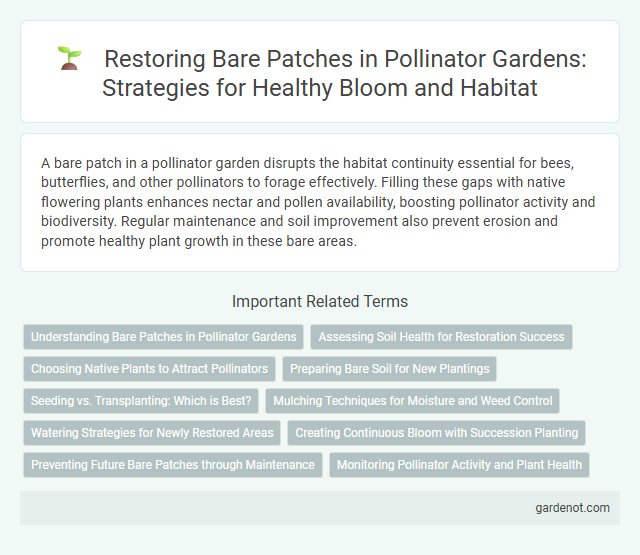A bare patch in a pollinator garden disrupts the habitat continuity essential for bees, butterflies, and other pollinators to forage effectively. Filling these gaps with native flowering plants enhances nectar and pollen availability, boosting pollinator activity and biodiversity. Regular maintenance and soil improvement also prevent erosion and promote healthy plant growth in these bare areas.
Understanding Bare Patches in Pollinator Gardens
Bare patches in pollinator gardens refer to areas lacking vegetation cover, which can negatively impact the habitat quality for bees, butterflies, and other pollinators. These patches often result from soil compaction, poor soil fertility, or invasive species outcompeting native plants essential for pollinator foraging and nesting. Addressing bare patches by introducing native flowering plants and improving soil conditions enhances biodiversity and supports pollinator health and population growth.
Assessing Soil Health for Restoration Success
Bare patches in pollinator gardens signal disrupted soil structure and nutrient imbalances that hinder plant growth essential for pollinator habitats. Assessing soil health involves testing pH, organic matter content, and microbial activity to determine restoration needs and appropriate amendments. Implementing soil improvement strategies based on these assessments enhances vegetation establishment and supports pollinator biodiversity.
Choosing Native Plants to Attract Pollinators
Selecting native plants for a pollinator garden effectively addresses bare patches by fostering local ecosystems and supporting pollinator species such as bees, butterflies, and hummingbirds. Native plants adapt to local soil and climate conditions, providing consistent nectar and pollen sources that enhance pollinator health and biodiversity. Incorporating a variety of native blooms with staggered flowering periods ensures continuous food availability, promoting sustained pollinator activity throughout the growing season.
Preparing Bare Soil for New Plantings
Preparing bare soil for new plantings in a pollinator garden involves loosening compacted earth to improve aeration and drainage, which enhances root growth for native wildflowers and nectar-rich plants. Incorporating organic matter such as compost or aged manure enriches soil nutrients, promoting vigorous blooming that supports butterflies, bees, and other pollinators. Proper soil preparation reduces weed competition, enabling young pollinator-friendly plants to establish quickly and thrive throughout the growing season.
Seeding vs. Transplanting: Which is Best?
Seeding bare patches in a pollinator garden allows for greater plant diversity and natural adaptation, promoting robust root systems that enhance soil stability and support native pollinators. Transplanting established seedlings offers quicker garden establishment and immediate floral resources but may cost more and require careful site preparation to reduce transplant shock. Choosing between seeding and transplanting depends on project timeline, budget, and the specific pollinator-friendly plant species suited to local soil and climate conditions.
Mulching Techniques for Moisture and Weed Control
Mulching techniques in pollinator gardens effectively address bare patches by retaining soil moisture and suppressing weed growth, essential for healthy plant establishment. Organic mulches like shredded bark or straw create a protective layer that reduces water evaporation and provides a habitat-friendly environment for beneficial insects. Consistent application ensures optimal soil temperature and nutrient cycling, enhancing overall garden vitality and pollinator activity.
Watering Strategies for Newly Restored Areas
Bare patches in pollinator gardens require targeted watering strategies to support plant establishment and soil health. Maintaining consistent moisture without overwatering encourages root development and prevents erosion in these newly restored areas. Utilizing drip irrigation or soaker hoses delivers water directly to the soil, minimizing evaporation and promoting efficient use of resources.
Creating Continuous Bloom with Succession Planting
Bare patches in pollinator gardens disrupt habitat continuity and reduce nectar availability, making succession planting essential for creating continuous bloom. Planting a carefully timed sequence of native wildflowers, such as coneflowers, bee balm, and goldenrod, ensures steady nectar and pollen sources from early spring to late fall. This strategy supports diverse pollinator species by providing uninterrupted food resources and improving overall garden health.
Preventing Future Bare Patches through Maintenance
Maintaining a pollinator garden requires regular soil aeration, consistent watering, and the removal of invasive weeds to prevent future bare patches. Applying organic mulch and planting ground covers help retain moisture and protect soil integrity, reducing erosion and promoting robust pollinator habitats. Monitoring plant health and reseeding bare areas promptly encourages continuous flowering and supports diverse pollinator populations.
Monitoring Pollinator Activity and Plant Health
Regular monitoring of bare patches in pollinator gardens involves tracking pollinator visitation rates and assessing plant health indicators such as leaf discoloration and growth patterns. Using digital tools like time-lapse cameras and mobile apps for data collection enhances accuracy in recording species diversity and pollination frequency. Early detection of stress factors and reduced pollinator activity enables timely interventions to restore plant vigor and support pollinator populations.
Bare patch Infographic

 gardenot.com
gardenot.com